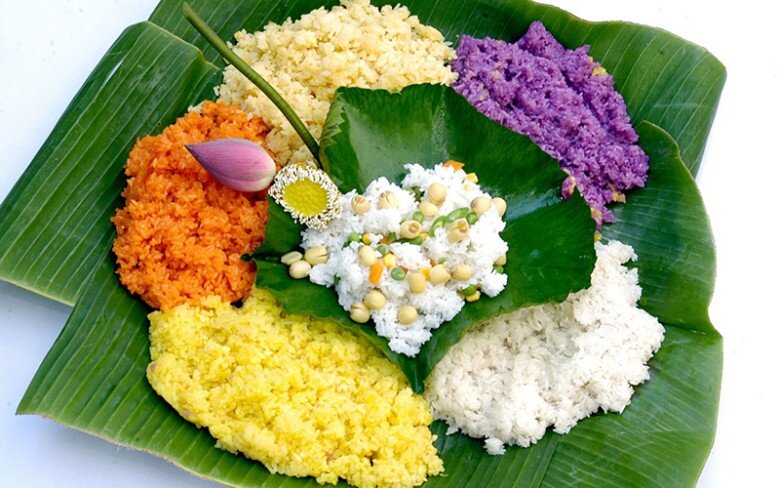BRAISED FISH
Braised fish is a traditional and familiar dish in family meals. Due to time constraints, many people only braise the fish once, but the dish tastes better when braised twice.
– First braise: After arranging the ingredients such as galangal, pork, and marinated fish in a pot, bring it to a boil. Then, add hot water, bring it to a boil again, cover, and simmer for about 40-45 minutes. This first braise makes the fish firm and absorbs the initial layer of spices, while also taking on a more attractive color. You can eat the fish at this stage, but for the best flavor, it’s recommended to braise it a second time.
– Second braise: Let the fish from the first braise cool completely before proceeding. You can add hot water to the pot, bring it to a boil, then reduce the heat and simmer until the liquid is almost completely reduced. At this point, the spices have deeply penetrated the fish, and the bones become soft and tender, making it very tasty.
– Reason for better taste with two braises: The combination of sweetness from the fish, the salty-sweetness of fish sauce, sugar, and other spices becomes more harmonious during the second braise. The fish meat becomes tender without falling apart, the braising liquid thickens, and the bones become soft and melt in your mouth, making it extremely delicious when eaten with white rice.
Similarly, many people have shared that braising meat twice also results in softer and more luscious textures.

GLUTINOUS RICE
Sticky rice is another dish that tastes better when cooked twice.
– First cook: After soaking glutinous rice for 6-8 hours, rinse it and place it in a steamer with boiling water. Steam the rice for about 30 minutes. At this point, if you eat the rice, it will be quite soft and sticky, but if you let it sit, it will become slightly dry and less tasty. Therefore, it needs to be cooked a second time.
– Second cook: After letting the rice cool down, cook it again to make the grains softer. When cooking it for the second time, sprinkle some water on the surface of the rice. The rice will not only become softer and more fragrant but also gain a shiny appearance and a softer, smoother texture, absorbing the aroma from the oil or coconut milk (if used).

FRIED SPRING ROLLS
Fried spring rolls are a traditional Vietnamese dish, often present in family meals. However, many people only fry their spring rolls once, resulting in a lack of crispiness. So, it’s recommended to fry them twice.
First fry: After finishing rolling the spring rolls, heat a large amount of cooking oil in a pan. Gently place the spring rolls into the hot oil, adding a few at a time to avoid overcrowding. Fry until the spring rolls are slightly hardened and have a pale yellow color. Then, remove them from the oil and place them on a plate lined with paper towels to absorb excess oil.
Second fry: Reheat the cooking oil, and fry the spring rolls again until they turn golden and crispy. Remove them from the oil and place them on paper towels to absorb any excess oil. Spring rolls fried twice are not only crispier but also more aromatic, absorbing less oil, making the dish less greasy.
Other fried dishes, such as chicken wings, French fries, etc., will also benefit from this double-frying technique.

VEGAN “PORK” WITH GALANGAL
Vegan “Pork” with Galangal is a dish famous for its rich and distinctive flavor! It is a familiar dish in family meals and is often enjoyed during chilly days.
First cook: The pork leg is charred over a fire to impart a unique aroma, then marinated with fermented rice, galangal, shrimp paste, turmeric, and other spices. The meat is stir-fried over high heat to seal in the juices and coat it with the initial layer of spices. Afterward, water is added, brought to a boil, and then simmered for about 20 minutes before turning off the heat.
Second cook: Allow the dish to cool completely, or even refrigerate it overnight. When ready to serve, reheat it, reduce the heat, and simmer until the meat is tender, and the spices are fully infused into the sauce and every fiber of the meat.
Why is vegan “pork” with galangal tastier when cooked twice?
– Deeper spice penetration: After the first cook, spices like fermented rice, shrimp paste, and galangal have more time to permeate the meat as it cools. The second cook enhances and harmonizes these flavors.
– Tender yet firm texture: Cooking the dish twice ensures that the pork leg is tenderized just right, with the skin and tendons becoming soft and chewy without falling apart.
– Enhanced aroma: Reheating the dish intensifies the aromas of shrimp paste, galangal, and fermented rice, resulting in a distinctive sour, sweet, salty, and pungent flavor profile.
– Richer and thicker sauce: The reheating process reduces the liquid, creating a slightly thick and intensely flavorful sauce that pairs perfectly with rice.
Tips for the best vegan “pork” with galangal cooked twice:
– Char the pork leg properly: Use charcoal or a gas stove to char the skin until golden and aromatic, avoiding excessive burning. This step is crucial for the dish’s unique flavor. If you live in an apartment, you can use a blowtorch to char the pork leg.
– Marinate for a longer time: Marinate the meat for at least an hour before cooking to allow the spices to penetrate deeply.
– Choose good-quality fermented rice: Ensure the fermented rice is mildly sour to achieve a well-balanced dish.
– Reheat over low heat: When cooking the dish again, use low heat to maintain its integrity without overcooking the meat.

Other dishes that benefit from double cooking include stir-fried shrimp, bamboo shoots soup, fried tofu, fried fish, French fries, and chicken wings. Give them a try!
“A Tasty Adventure: Spicy, Garlic-Chilli Fish Stew – A Delicious Side to Hot Rice”
With this mouth-watering recipe, you can take your family meals to the next level. This delicious fish dish, simmered in a garlic chili fish sauce, is a flavor explosion that will tantalize your taste buds and impress your loved ones. It’s a perfect blend of spices and flavors that will make your meal extraordinary.
“The Ultimate Guide to Brewing Delicious Sweet Rice Wine for Tết Đoan Ngọ”
“Rice wine is a traditional delicacy, often enjoyed during the festive season of Tết Đoan Ngọ. It’s not just a tasty treat but also boasts a multitude of health benefits. This Tết Đoan Ngọ, embrace your culinary skills and craft this delicious dish for your loved ones. It’s a perfect way to celebrate and nurture your family’s well-being.”



































